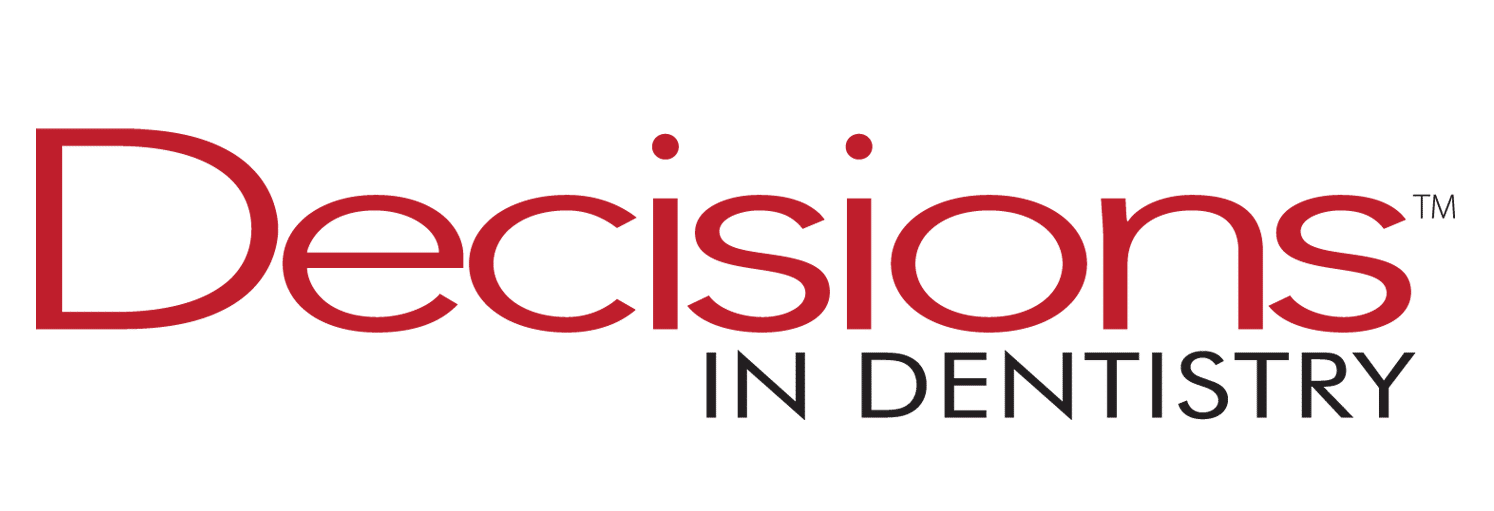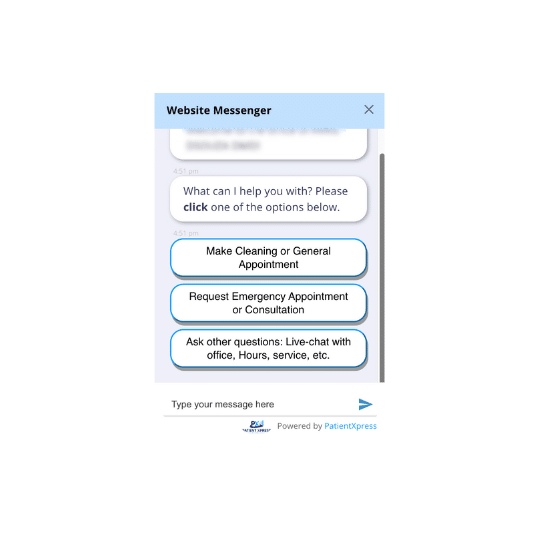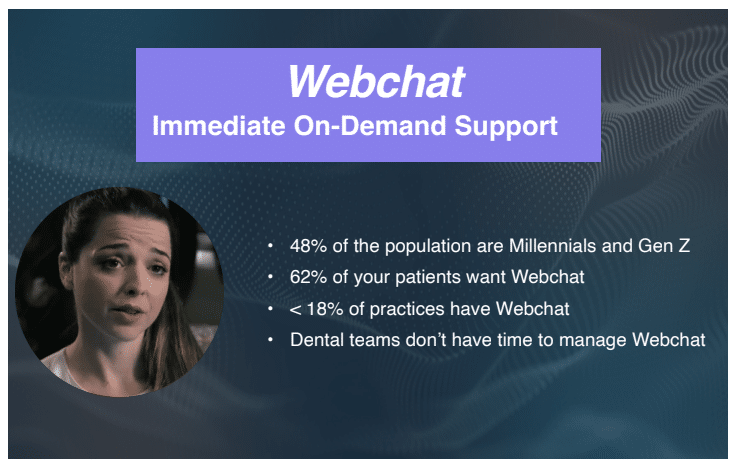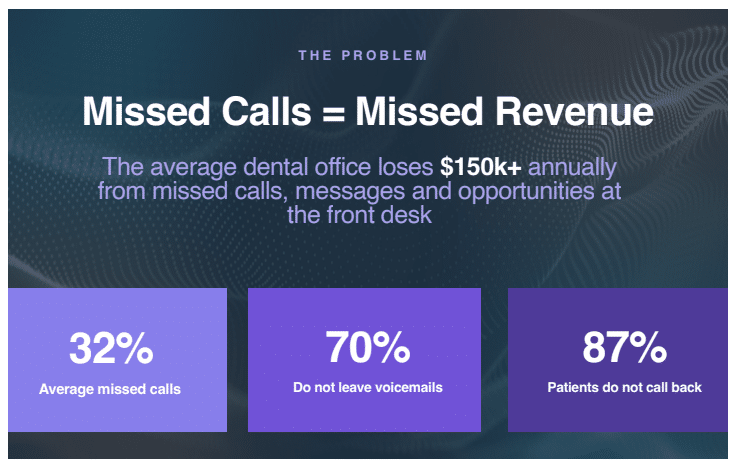
What’s the Difference Between a Dental AI Agent and a Chat Bot?
As a dental professional, you’ve likely heard the buzz about AI and its potential to revolutionize workflows in dental practices. From enhancing patient communication to streamlining administrative tasks, AI is reshaping how practices operate. However, with so many terms and technical explanations floating around, it’s easy to feel overwhelmed and unsure where to begin.
We get it—it can be confusing to navigate all the jargon. That’s why we’re here to simplify things for you. In this guide, we’ll break down the key differences between a traditional chatbot and a dental AI Agent so you can see why AI Agents are becoming the go-to solution for modern dental practices.
But first, let’s clarify the terminology. Anything developed before the advent of generative AI will be referred to as a “Bot.” You might be familiar with these traditional systems—limited scope and reliant on pre-programmed responses.
On the other hand, anything leveraging generative AI technology, designed to learn, adapt, and engage more naturally, will be referred to as an “Agent.” This distinction will help you better understand the advancements we’re discussing.
Relax and read on as we clear the air and help you make sense of this cutting-edge technology.
What is a Chatbot?
A chatbot is an automated computer conversational tool to communicate with you. You might have encountered a chatbot on a website or in an app—it usually appears as a little chat window in the bottom corner of the screen. Often, there’s a speech bubble icon or a friendly greeting like “Hi there! How can I help you today?”
When you interact with a chatbot, it feels like sending messages in a text conversation. The chatbot will typically have:
- A Chat Box: This is where you type your questions or select options. It’s like texting on your phone, but instead of a person, a bot is replying.
- Quick Replies or Buttons: Sometimes, you’ll see buttons with suggested answers or questions you can click, like “Book an Appointment” or “Learn More.”
- Automated Responses: After you type or click, the chatbot will send a reply almost instantly, often using friendly and simple language.
For example, if you visit a dental website, the chatbot might greet you with, “Hi! Need help finding an appointment? Click below to get started!” You can then type something like, “I want to schedule a cleaning,” and the chatbot will guide you step-by-step.
How Do Chatbots Work?
Chatbots are programmed to recognize familiar words and phrases. For instance, if you type “I need help,” the chatbot might recognize the word “help” and respond with, “Sure! What can I assist you with?” Chatbots work like guides, giving you the answers you’re looking for based on the instructions they’ve been previously programmed to follow.
These basic chatbots function similarly to the menu trees used in automated phone systems, where users select from a list of options to get their answers. However, this system works only if patients stay within the “lines” of what the chatbot is programmed to handle.
Watch this video to see a chat bot in action. Please notice the painstaking delay in the chatbots responses.
Integrating a Chatbot
Creating a chatbot requires significant effort, as it relies on what you program into it. First, you must identify common customer questions, such as “What are your hours?” For each question, you must create a scripted response.
However, to ensure the chatbot recognizes various ways customers might phrase a question, you’ll need to provide dozens, if not hundreds, of examples. This helps the chatbot match the query to the correct response.
While building an effective chatbot using this method is possible, the process is time-consuming and difficult to scale. Constantly scripting, updating, and managing the growing complexity of conversation flows becomes a significant challenge, limiting the chatbot’s long-term efficiency.
See an example of a chatbot.
The Limitations
Chatbots come with significant limitations. They struggle with understanding complex or unusual questions, as they rely on pre-programmed keywords and scripts. This means that spelling errors or modern acronyms can confuse them. For example, if someone types “Can I bok an appt?” instead of “Can I book an appointment?” a basic chatbot might not recognize the intent and respond with confusion. Similarly, modern acronyms like “IDK” or “FYI” might be misinterpreted unless explicitly programmed into the chatbot’s logic. This often leads to irrelevant or unhelpful responses.
Chatbots offer generic answers that can feel robotic, especially when users need tailored guidance like insurance details or treatment options. While chatbots are great for answering FAQs or scheduling appointments, they fall short with nuanced or complex tasks, like detailed advice on dental treatments.
Chatbots are designed to save time, but for many dental practices, they end up creating more work. Managing after-hours and weekend chats often results in an overwhelming number of messages to handle on Monday mornings. Instead of streamlining workflows, chatbots can become a burden, requiring significant effort to sort through conversations and respond effectively.
This is the problem, as it defeats the very purpose of using a chatbot, which is supposed to reduce workload and free up valuable time for the team. For this reason, many dental practices are shifting to more advanced solutions like AI Agents to better serve their patients.
Now that we understand what a chat bot is, let’s move on to learn more about AI Agents.
What Is a Dental AI Agent?
A Dental AI Agent is a next-generation virtual assistant explicitly designed to help dental practices manage patient interactions. AI Agents use advanced technologies like Natural Language Processing (NLP) and Large Language Models (LLMs) to understand, think, and respond in a human-like way.
What is that, you ask? Well, NLP is the field of computer science that focuses on enabling machines to understand, interpret, and respond to human language, like recognizing and analyzing text. LLMs build on that foundation to deliver richer, more context-aware, and human-like interactions. Think of NLP as teaching a computer the “ABCs and rules of language” and LLMs as empowering it to converse like a person.
How Do Dental AI Agents Work?
A Dental AI Agent can process and analyze patient inquiries in real-time. They think critically rather than simply following a script. They can adapt their responses based on the patient’s input and ask clarifying questions. It goes beyond merely recognizing keywords and instead understands the context of the question. For example:
- If a patient asks, “Can I book a cleaning on Thursday at 2 PM?” the AI Agent doesn’t just detect the word “cleaning.” It interprets the complete request, checks for available appointments, and provides options or confirmations.
- It can also handle follow-up questions and adjust responses dynamically, such as answering, “What’s the cost for teeth whitening?” and then seamlessly scheduling the service if the patient is interested.
Beyond answering questions and scheduling appointments, they can send reminders and provide care instructions. Integrated with your practice system, they handle tasks automatically, even after hours. This helps reduce your team’s workload and improves patient satisfaction so you can focus on in-person care.
Check out how a Dental AI Agent named Annie chats.
How Do You Integrate a Dental AI Agent into Your Practice?
Integrating an AI Agent, like Annie AI, into your practice is a simple process. Here’s how it works:
- Initial Setup and Customization
During the onboarding process, the AI Agent is explicitly tailored to your practice. It is trained with detailed information about your services, office hours, accepted insurance plans, and common patient inquiries. This customization ensures the AI Agent can provide accurate and relevant responses aligned with your practice’s offerings and protocols.
- Integration with Your Practice Management System (PMS)
The AI Agent connects directly to your PMS, allowing it to access real-time data about appointment availability, patient records, and other essential details (while adhering to privacy regulations). This integration enables the AI Agent to handle tasks like booking appointments, confirming times, making scheduling changes, and even referencing patient-specific information when needed.
- Testing and Optimization
Before going live, the AI Agent is tested extensively to ensure it understands and responds appropriately to patient questions. During this phase, any needed adjustments are made to optimize its performance and align it with your practice’s needs.
- Continuous Learning and Improvement
Once live, the AI Agent continues to learn and improve. As it interacts with patients, it adapts based on feedback and usage patterns. Updates can be made to reflect new services, changes in office policies, or other practice-specific adjustments. This ensures the AI Agent remains accurate, relevant, and up-to-date.
- Launch and Ongoing Monitoring
The AI Agent is deployed on your website. After launch, its performance is monitored, and periodic updates are applied to maintain seamless operation and continuously improve patient interactions.
By integrating a Dental AI Agent into your practice, you streamline operations, enhance patient communication, and free up your team to focus on delivering exceptional in-person care.
Why Patients Prefer Webchat
Millennials and Generation Z, who now comprise nearly half of the global population, have grown up in an era defined by instant messaging and online communication. Texting and chatting online are second nature for these generations, shaping how they interact with businesses and services.
Unlike older generations, who are more accustomed to making phone calls, Millennials and Gen Z prioritize speed, convenience, and flexibility in their communication. They prefer to send messages and receive quick responses, allowing them to multitask and avoid the formality of a phone call. In fact, 62% of today’s patients want webchat as an option, yet less than 18% of dental practices offer it.
This shift in communication habits has created a strong demand for web chat and other messaging platforms in dental practices. To effectively engage with this tech-savvy demographic, businesses must adapt by offering seamless, responsive digital communication options.
The Solution: Dental AI
Basic chatbots take too much time to manage and often fall short in delivering the level of service these tech-savvy patients expect. The only effective way to tap into this growing group of potential patients is through AI.
AI-powered agents provide instant, accurate responses, handle complex questions, and seamlessly manage patient interactions, ensuring no opportunity is missed. By embracing dental AI, practices can meet the communication preferences of today’s younger patients while reducing the workload of their staff and driving more revenue.
Dental AI: Breaking Language Barriers
Another standout feature of AI is its ability to communicate in multiple languages. In the U.S., many Spanish speakers may feel hesitant to make phone calls due to limited English proficiency, leaving them feeling isolated when seeking dental care.
A web chat powered by Dental AI allows these patients to communicate comfortably in their own language, making it easier to ask questions, schedule appointments, or handle dental emergencies. This bilingual capability ensures inclusivity and builds trust and confidence, showing patients that your practice is committed to meeting their needs, regardless of language barriers.
By offering this level of accessibility, your practice can expand its reach and create a welcoming environment for non-English speakers.
Why Stop at Webchat? Integrate Dental AI into Your Phone System
While Dental AI Agent web chat is an excellent tool for engaging tech-savvy Millennials and Generation Z, it’s not enough to capture all patient interactions. Missed calls are a significant source of lost revenue for dental practices.
Research shows that 32% of calls go unanswered, and of those, 70% of callers don’t leave a voicemail, with 87% never calling back. These missed opportunities often represent potential patients who will quickly move on to another provider.
Missed Calls = Missed Revenue
Missed calls mean many potential patients slip through the cracks simply because they couldn’t connect when they reached out. In today’s fast-paced world, patients expect immediate responses, and when they don’t get them, they move on to another provider.
Limiting AI to web chat alone only addresses part of the problem. Integrating Dental AI into your phone system ensures no patient inquiry slips through the cracks—even outside of business hours.
Introducing Annie AI: The Dental AI Agent That Answers Calls Anytime
Annie AI, your Dental AI Agent, goes beyond webchat by integrating seamlessly with your phone system to answer calls after hours, on weekends, and even during busy office hours. Annie ensures that patients always receive immediate attention, whether inquiring about a treatment, scheduling an appointment, or experiencing a dental emergency. With Annie AI handling your phones, missed calls become a thing of the past, allowing you to capture every patient opportunity while easing the workload on your staff.
By combining webchat and phone integration, Annie AI provides a comprehensive solution for engaging patients, boosting satisfaction, and maximizing revenue—all while keeping your practice running efficiently.
Have a listen to a recent patient phone call with Annie or call her yourself.
Don’t Let Your Marketing Efforts Go to Waste
Investing in dental marketing to attract new patients is essential. Still, it’s pointless if those patients can’t connect with your practice. Imagine spending time and money on ads, social media, and SEO to drive traffic, only to miss calls, messages, or inquiries because your team is overwhelmed or unavailable.
When patients encounter unanswered calls, delayed responses, or poor communication, they’re likely to move on to another provider—taking potential revenue with them. Effective marketing doesn’t stop at attracting patients; it depends on seamless communication to convert interest into appointments. Ensuring every patient can connect through phone or web chat is the key to turning your marketing investment into real practice growth.
Don’t hesitate to schedule a demo of Annie.
FAQs
- Can a Dental AI Agent handle multiple tasks at once?
Yes, an AI Agent can handle multiple inquiries simultaneously without slowing down or losing accuracy. The AI Agent can seamlessly manage these tasks whether patients are asking about scheduling, treatment options, or insurance coverage. In contrast, a traditional chatbot might get overwhelmed or fail to address complex, multi-task interactions.
- How does an AI Agent manage follow-up conversations?
A Dental AI Agent can pick up where the conversation left off, maintaining context and continuity. For example, if a patient inquires about teeth whitening but needs time to decide, the AI Agent can follow up later to confirm their interest. Traditional chatbots often lose context and require patients to repeat information.
- Can Dental AI handle nuanced questions about treatments?
Yes, AI Agents can answer detailed questions about procedures, treatment options, and aftercare by understanding the context and using its extensive database. Chatbots, on the other hand, struggle with nuanced inquiries and typically provide generic or incomplete answers.
- What happens if I need to speak directly with the Dental Office team?
An AI Agent can seamlessly transfer you to someone in the dental office when needed. If your inquiry requires personal assistance, the AI Agent will identify the issue and connect you with the appropriate team member. This can be done through a live call transfer, flagging the message for immediate follow-up, or scheduling a callback at a convenient time for the patient.
The AI Agent acts as a first point of contact, handling routine inquiries and tasks to save time. It also ensures that complex or urgent matters are promptly escalated to the right person in the office, guaranteeing a smooth and efficient communication experience for both patients and staff.
- How do Dental AI Agents handle language barriers better than chatbots?
AI Agents are multilingual and can respond in multiple languages, making them more inclusive for non-English speaking patients. Chatbots often need to be pre-programmed with specific languages and lack the flexibility to switch seamlessly or understand diverse phrasing.







